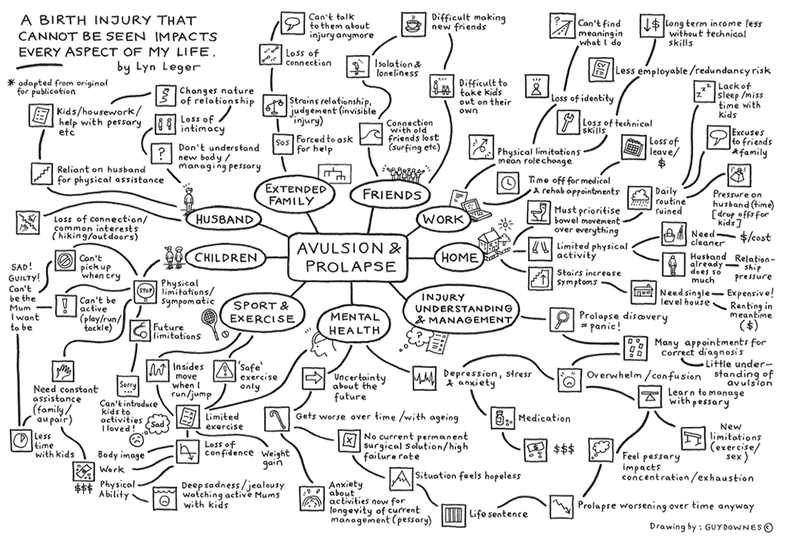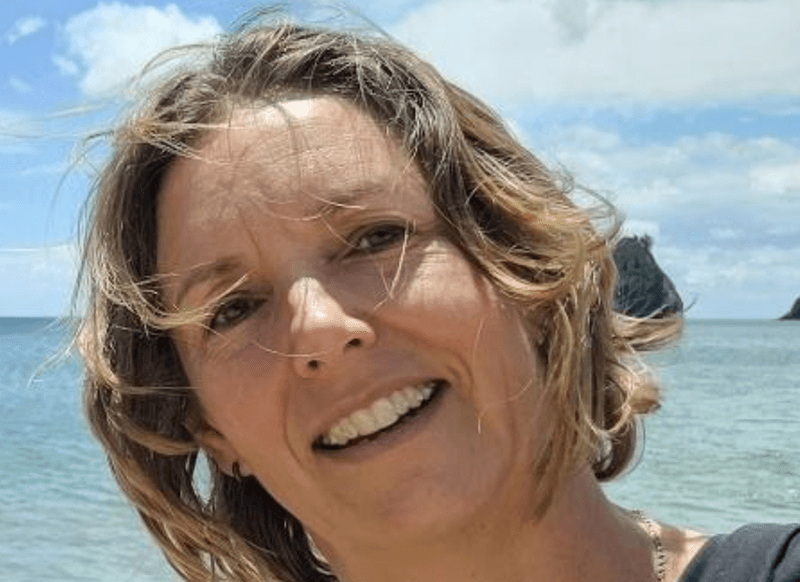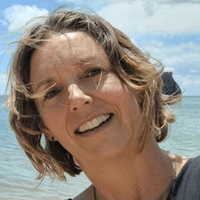This should have been a special time getting to know my new baby. Instead, I found myself slipping into a dark and confusing period, not knowing what was wrong with me. Among other things, it impacted my ability to parent and to bond with my baby.
I got pregnant again quite quickly, through painful sex, and had a second child in 2018.
Five weeks after the birth of my second child I discovered a bulge (pelvic organ prolapse) at the entrance of my vagina. I was horrified and scared! This began six months of MANY appointments with my obstetrician, multiple GPs, four different pelvic floor physios and a urogynecologist. It took me a while to find a GP who understood it wasn’t only older women who had prolapse, and a pelvic floor physio who could palpate to diagnose avulsion. During this time I was told by more than one practitioner to ‘stop catastrophising’.
The imaging by the urogynecologist finally confirmed it all for me… I have bilateral avulsion of the levator ani muscle, as well as three compartment prolapse. The diagnosis was devastating.
For a long time, I couldn’t speak to anyone openly about the injury, except for my husband. This was because I couldn’t see it and couldn’t understand it. I couldn’t understand what all the impacts were to my life as I was still discovering them daily. If anyone asked how I was, I would either lie and say “good thanks” or burst into tears trying to tell them. I felt so isolated, and so alone.
Over the following months, I started to get a better picture of the impacts and how I would need to manage the levator avulsion and prolapses for the rest of my life. These impacts – both current and future – became so overwhelming that I began experiencing suicidal thoughts. This was a deeply distressing and unexpected moment in my journey, and I’m grateful that I was able to reach out for help and am still here today to share my story.
After this event, I realised I needed serious and urgent help for my mental health. I saw my GP and was prescribed antidepressants, and while these aren’t for everyone, they helped me immensely in this time of crisis. Also, I found a psychologist and began regular appointments, including the use of EMDR. After one of my early appointments with the psychologist, I drew a ‘mind map’ of the many impacts that levator avulsion and prolapse had already had on my life. It shows how my birth injury, which cannot be seen, impacts EVERY aspect of my life; everything from the physical aspects of the injury, managing a pessary, fitting in the required ongoing rehabilitation, to my work, home and social life, mental and physical health and well-being, my relationship with my husband, children and extended family, and my ability to look after my own children. Making this mind map helped me to recognise the many layers of impacts, how they are interrelated, and why I felt so overwhelmed. I want to share this image so that others may be able to better understand their own injuries and impacts, and hopefully feel less overwhelmed by them.

Additionally, I reached out to speak to others with levator avulsion. I went to a face-to-face session held by Birth Trauma Australia and spoke to women who had the same injury as me. We discussed which practitioners they were going to, their struggles, and the things that had helped them overcome various challenges. However, the thing that helped me the most was just knowing there were other women out there dealing with the same injury and similar challenges. Online communities helped me in this way too, including Facebook groups such as an Australian pelvic organ prolapse group, Pelvic Floor Avulsion support group, and Birth Trauma Australia support group. I could ask questions and get answers from women with lived experience, who understood what I was going through. My journey with levator avulsion continues. One thing is for sure, as I age and go through menopause, things will get worse. I have tried to set myself up with good friends and professional support networks, and despite my anxiety about the future, I will just have to take each day as it comes.
Since I was diagnosed with levator avulsion and prolapse, I have read many articles from peer-reviewed journals in an effort to understand my injury.
- Approx 1 in 5 women sustain levator avulsion during their first delivery (with the incidence of avulsion reported at 13–36%, or up to 1 in 3 in some studies)
- Avulsion has been found in up to 66% of women after forceps deliveries
- 36% of women with prolapse have underlying avulsion
Realising how common this injury is, I thought surely there is a surgical fix for me and searched for more information. However, I discovered there is no surgical solution for avulsion. At best, surgery for avulsion is considered experimental. Additionally, while prolapse surgeries are relatively common, they have a high re-operation rate, around 30%, and my urogynecologist explained to me that for women with avulsion, the failure rate of prolapse surgery is much higher, around 70- 80%.
To say these statistics are shocking to me is a gross understatement. It was even more shocking to me that NOTHING big is being done to help women with birth injuries when the scale of the problem is obviously HUGE!
Listening to the news on the radio one day, hearing about endeavours to send spacecraft to Mars, and establishing communities on the Moon, I got incredibly angry. How is this fair? Somehow, millions, probably billions of dollars are poured into R&D for these activities in space, but we can’t fix a woman’s vagina after she gives life to another.
Birth injuries are a major public health issue, with long-term physical and psychological effects that severely impact the lives of thousands of women every year. I believe that immediate action is required to secure funding for the diagnosis, treatment and rehabilitation of birth injuries, which are often overlooked in discussions about women’s health.
I shared my recommendations for action, as well as my mind map, with the 2023 NSW Parliamentary Inquiry into Birth Trauma.
I really want the Government to implement my recommendations
- Ensure that funding can be allocated to research on diagnosis, treatment and management of levator ani avulsion, commensurate to the economic burden of avulsion
- Address gender bias in the health system and health research by focusing on issues that impact women’s health and quality of life.
- Improve the lives of women with birth injuries by ensuring access, early diagnosis, affordability of medical and allied health services, and long-term treatment and management options.
- Provide a positive impact on the economy and society as women with avulsion will more likely be able to participate fully in society again.


